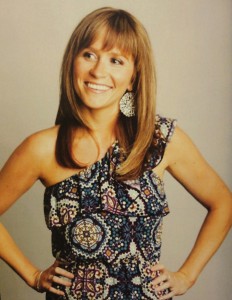By Kaitlyn Boisvert –
“Tanning Is Out. Your skin is in”
This was the slogan of the presentation that Meghan Rothschild held on Nov. 3 in O’Hare’s Academic building. About 20 attendees were present, and each got the chance to learn important facts about tanning salons and skin cancer.
There was a collective intake of breath upon the startling statistics and the photos provided in the presentation. Although the subject matter of the evening was clearly not very light-hearted, it succeeded in conveying an important message regarding an all-too-real issue. “It is a common belief that tanning is safe,” said Rothschild, “yet people do not realize that tanning beds expose people to 3-6 times the radiation rays than the sun does, and it increases peoples’ risk for developing cancer. Yet there are so many people that do not know this, and thus continue to endanger themselves.”
As a survivor of melanoma, a form of skin cancer, it has become one of Rothschild’s main goals to address the issue of skin cancer, and inform people of the dangers of tanning.
As is apparent from many popular television shows, tanning is an epidemic that greatly affects the young demographic. Coincidentally, Rothschild revealed that melanoma is the second most common form of cancer in people from ages 15-29.
Tanning salons can potentially be the cause of this, as the UV rays released from tanning beds contain carcinogens, which can cause this disease to develop and spread.
Despite this fact, Rothschild revealed that many people still go tanning, as salons draw in more than a million people per day.
At one point in time, Rothschild had been one of these people. As a teenager, Rothschild felt very self-conscious of her fair complexion and began to frequent tanning salons in order to give her skin a darker color.
She developed a ritual of salon-hopping once a week, for 20-minute sessions. To her, it seemed harmless. “I had the sense that I did not have to worry about skin damage or cancer,” she commented. “It all seemed like it was something that other people had to worry about, and there was no chance that it could ever happen to me.”
Rothschild continued to live harm-free as she still visited the salons, until she discovered a new dark-colored mole on her body in December 2003.
At the time, she was a college student attending Roger Williams University, majoring in Journalism. Upon seeking a doctor’s insight, Rothschild was told that it was non-threating, and she could get it removed. She complied, and went tanning later that day, with stiches in place.
A month later, she returned to get her stiches removed. She had been assigned a new doctor, who did not have the same comforting news as the previous doctor. “I remember him asking me if there were any family members with me,” she reminisced. “He kept insisting that if there were any, they had to come into the room and hear the news he had to tell me. I immediately knew then that something was wrong.”
Rothschild was right to feel this way, as the doctor proceeded to inform Rothschild that at 20 years old, she had melanoma. This news came as a huge shock to her, yet her initial reaction was anger. “I was so mad at myself,” she said. “I knew that it was because of the bad choices that I had made over the past three years I had endangered my own body.”
Following the diagnosis, Rothschild had to undergo surgery to remove eight lymph nodes from her body. Such a procedure is common upon skin cancer patients, as it helps ensure that the cancer does not spread further in the body, which can lead to death.
After seeing her doctor, Rothschild went to an oncologist, a medical expert who specializes in cancer treatment. Upon being examined, Rothschild was instructed to stop tanning, to regularly apply SPF, and to avoid the sun from 10 a.m. to 2 p.m. on hot days.
Although Rothschild was lucky that she was able to treat her melanoma before it spread, she had to take cautionary steps to prevent herself from falling victim to it again. Survivors of melanoma are at greater risk to get the disease, and it has the potential to be more fatal if caught again.
Although she acknowledged that she was fortunate to be a survivor of such a dangerous disease, Rothschild emphasized that skin cancer is not easily curable, and she still suffers because of its effects.
Ever since her diagnosis, Rothschild has had over 30 moles removed from her skin, and still needs to go to the oncologist in order to discover if any more need to be treated.
What is the most agonizing for her is the irreversible damage that has already been rendered on her body. She presented a picture of a diagram that showed all the sun damage she had, with many dark areas lining her face.
“It makes me angry to see that I had done all this damage to myself before I was even of the legal age to buy a drink,” she said. “But, in a way, some good has come out of what happened to me. If I had not gotten melanoma, I would never have reached where I am today, with my campaign to share my experience and inform people about this disease.”
As an employee for the Melanoma Foundation of New England and the Founder of SurvivingSkin.org, Rothschild makes it her mission to ensure that others do not make the same mistake as she did.
Her devotion to bringing awareness to tanning and melanoma has gotten her much recognition, as Cosmopolitan magazine awarded her for her work at their annual awards ceremony of last year.
Rothschild has spoken at Salve Regina University for the past four years, and according to Salve Health Coordinator, Paul Cardoza, Salve will continue to welcome her to speak. “Her story and message are just so important,” he said. “Students can really take it to heart, because at a school near a beach, they are often in the sun.”
Salve student Courtney Russell, a sophomore, was one of the attendees who found Rothschild’s presentation to be very powerful.
“It really scared me,” she confessed. “I usually go tanning twice a week. But now, I am definitely going to try to change that.”
Such a comment marks a triumph in Rothschild’s intention: to encourage people to be more effective in their skincare routine. She discouraged tanning salons, saying that people have the alternative and ultimately safer option of using spray tans.
Rothschild also emphasized the importance of regularly using sunscreen with an SPF level of 30 or more, using an amount that could “fill up a shot glass” in one use, and then reapplying two hours later.
Rothschild also told her audience to consult a dermatologist for moles that change in color or look suspicius
“The skin is the largest organ on our body,” she said. “We should not take it for granted.”
Some of Meghan’s Skin Safety Rules:
1. Get a full skin exam yearly if you are over 18.
2. Avoid sunburns, tans, and tanning beds.
3.Wear a hat with a brim, sunglasses, and as much clothing as is comfortable in the sun.
4. Use plenty of sunscreen (at least SPF 30) and reapply often.
5. Wear sunscreen daily on any skin exposed to the sun.
6. See your doctor if any of your moles change.
To learn more about skin safety and melanoma, visit the Melanom Foundation of New England’s website: www.mfne.org ot Meghan Rothschild’s campaign website at: www.survivingskin.org















